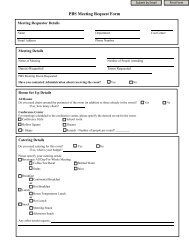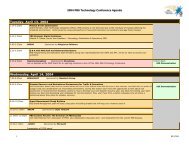Dolby LM100 Broadcast Loudness Meter - PBS
Dolby LM100 Broadcast Loudness Meter - PBS
Dolby LM100 Broadcast Loudness Meter - PBS
You also want an ePaper? Increase the reach of your titles
YUMPU automatically turns print PDFs into web optimized ePapers that Google loves.
<strong>LM100</strong><br />
<strong>Broadcast</strong> <strong>Loudness</strong> <strong>Meter</strong><br />
The <strong>Dolby</strong> <strong>LM100</strong> <strong>Broadcast</strong> <strong>Loudness</strong> <strong>Meter</strong> is a tool for measuring the subjective<br />
loudness of dialogue within broadcast programming.<br />
Differences in audio levels between programs, or between<br />
programs and commercials, are a major annoyance to TV viewers.<br />
However, although obvious to the viewer, these differences have<br />
proven difficult for broadcasters to measure with conventional<br />
methods and equipment.<br />
The <strong>Dolby</strong> ® <strong>LM100</strong> <strong>Broadcast</strong> <strong>Loudness</strong> <strong>Meter</strong> solves that<br />
problem through Dialogue Intelligence, a revolutionary<br />
technology developed specifically to measure the perceived<br />
loudness of dialogue. Research shows that most viewers adjust<br />
TV volume to normalize dialogue levels. By analyzing the input<br />
signal and measuring program loudness only during the presence<br />
of speech, Dialogue Intelligence objectively measures what<br />
viewers subjectively experience.<br />
Applications<br />
Applications for the <strong>LM100</strong> range from postproduction and<br />
quality control to final transmission, program turnaround,<br />
and cable head-end facilities.<br />
Easy-to-Read Measurements<br />
The <strong>LM100</strong> presents its measurements in an easy-to-understand<br />
numerical format. This eliminates the variations in results multiple<br />
operators often find when using VU or PPM meters, neither of<br />
which were designed to measure subjective loudness. The <strong>LM100</strong><br />
can also determine the unweighted peak and a range of other<br />
information about the signal.<br />
The unit can simultaneously display the incoming dialogue<br />
normalization (dialnorm) value of a <strong>Dolby</strong> Digital program (or any<br />
program within a <strong>Dolby</strong> E bitstream) for direct comparison to the<br />
actual measured value. Front- and rear-panel serial interfaces<br />
provide capabilities for software updates and the <strong>LM100</strong> software<br />
remote application. The remote application will assist users with<br />
advanced loudness measurement, logging features, and<br />
enhanced error reporting.<br />
A set of user-definable alarms and monitoring functions can<br />
inform an operator of input loss, signal clipping, overmodulation<br />
(<strong>LM100</strong>-NTSC version), high or low signal levels, silence, and<br />
incorrectly set dialnorm values.<br />
Configurations<br />
The <strong>LM100</strong>-LTC includes a timecode input, which allows alarm<br />
and other signal conditions to be logged to either the internal<br />
time-of-day clock or external timecode. The <strong>LM100</strong>-NTSC includes<br />
an RF input specifically for NTSC CATV and “off-air” television<br />
measurement applications. Because the RF tuner replaces the<br />
linear timecode input in this version, logging is referenced to<br />
the internal clock.
<strong>Dolby</strong> <strong>LM100</strong> <strong>Broadcast</strong> <strong>Loudness</strong> <strong>Meter</strong><br />
<strong>LM100</strong> Front Panel<br />
Multifunction Display<br />
Intuitive, easy-to-read user interface; input<br />
source selection determines display parameters<br />
Keypad<br />
Enables local control of setup functions<br />
and status display<br />
<strong>LM100</strong> Rear Panel<br />
Alarm LEDs<br />
Audio alarm, fault, error<br />
Headphone Output<br />
(For confidence monitoring) 6.35 mm<br />
(1/4 inch) standard stereo headphone jack,<br />
level-adjustable<br />
RS-232 Serial Remote Input<br />
(For the <strong>LM100</strong> software remote application<br />
and software upgrades) 8-pin female<br />
mini-DIN connector<br />
Digital Audio Input<br />
BNC female connector with loop-through,<br />
unbalanced, 75Ω, signal levels per<br />
AES-3ID-1995 (SMPTE 276M), external<br />
75Ω termination required<br />
Formats supported: PCM data up to 24 bits;<br />
<strong>Dolby</strong> E data supported in 16-, 20-, and 24-bit<br />
modes at 48 kHz; <strong>Dolby</strong> Digital (AC-3) data at<br />
32, 44.1, and 48 kHz sample rates<br />
Analog Audio Inputs<br />
Two Neutrik ® combination XLR/¼ inch TRS<br />
connectors, electronically balanced<br />
Maximum input level: ~ +22 dBu<br />
Input impedance: 10 kΩ<br />
User-definable nominal operating levels<br />
Analog Audio Outputs<br />
Two RCA-type connectors, unbalanced, stereo<br />
Maximum output level: 2 V RMS into a 10 kΩ<br />
load per IEC 61938<br />
Timecode Input (<strong>LM100</strong>-LTC version)<br />
BNC female, unbalanced, per SMPTE 12M-1999<br />
RF Input (<strong>LM100</strong>-NTSC version)*<br />
F-type female connector with internal<br />
75Ω termination<br />
Tuner frequency range: 55.25 to 801.25 MHz<br />
Supports BTSC encoded stereo signals<br />
Selectable CATV or “off-air” modes<br />
CATV mode supports the Cable Television<br />
Channel Identification Plan per EIA 542<br />
(User selectable: Standard, HRC, or IRC)<br />
Video output: composite, BNC female<br />
*NTSC M standard only; RF tuner replaces LTC input on this<br />
version, as shown.<br />
Serial Remote Control Input<br />
9-pin female D-connector, RS-485<br />
(SMPTE 207M)<br />
Alarm Port<br />
9-pin female D-connector, 0–5 V TTL level<br />
User-definable alarms: input clip detection,<br />
modulation overload, loudness above<br />
threshold, loudness below threshold (silence),<br />
dialnorm threshold, and AES input loss<br />
General Purpose Input/Output (GPI/O) Port<br />
9-pin female D-connector, 0–5 V TTL level<br />
Functions include: measurement pause,<br />
measurement reset, input source select,<br />
channel up/down (<strong>LM100</strong>-NTSC only),<br />
measurement state<br />
Core Measurement Algorithm<br />
Leq(A) (IEC 60804)<br />
Dialogue Intelligence Algorithm<br />
Proprietary; patent pending<br />
Audio Sampling Rates<br />
32, 44.1, and 48 kHz<br />
Measurement/Analysis System Log<br />
480 events stored in internal nonvolatile RAM<br />
Unlimited event storage and retrieval with use<br />
of <strong>LM100</strong> software remote application on a PC<br />
Power Requirements<br />
90–264 VAC, 50–60 Hz, auto-sensing, 15 W<br />
maximum; unit designed to operate from a<br />
centrally switched power source<br />
Dimensions and Weight<br />
1-U rackmount: 44 × 483 × 375 mm<br />
(1.75 × 19 × 14.75 inches)<br />
Net: 2.5 kg (5.5 lb)<br />
Environmental Conditions<br />
Operating: 0° to 50°C (32° to 122°F), natural<br />
convection cooling, 0 to 98% relative humidity<br />
(noncondensing)<br />
Nonoperating: –20° to +70°C (–4° to +158°F)<br />
Regulatory Notices<br />
North America: This unit complies with the<br />
limits for a Class A digital device pursuant<br />
to Part 15 of the FCC rules, and is UL Listed<br />
for both US and Canada.<br />
Europe: This unit complies with the requirements<br />
of Low Voltage Directive 73/23/EEC and EMC<br />
Directive 89/336/EEC and carries the CE<br />
marking accordingly.<br />
Warranty<br />
One-year limited, parts and labor; see disclaimer.<br />
Specifications subject to change without notice.<br />
Disclaimer of Warranties<br />
Equipment manufactured by <strong>Dolby</strong> Laboratories is warranted against<br />
defects in materials and workmanship for a period of one year from the<br />
date of purchase. There are no other express and implied warranties and<br />
no warranty of merchantability or fitness for a particular purpose, or of<br />
noninfringement of third-party rights (including, but not limited to,<br />
copyright and patent rights).<br />
Limitation of Liability<br />
It is understood and agreed that <strong>Dolby</strong> Laboratories’ liability, whether<br />
in contract, in tort, under any warranty, in negligence, or otherwise<br />
shall not exceed the cost of repair or replacement of the defective<br />
components or accused infringing devices, and under no circumstances<br />
shall <strong>Dolby</strong> Laboratories be liable for incidental, special, direct, indirect,<br />
or consequential damages (including, but not limited to, damage to<br />
software or recorded audio or visual material), cost of defense, or loss of<br />
use, revenue, or profit, even if <strong>Dolby</strong> Laboratories or its agents have been<br />
advised, orally or in writing, of the possibility of such damages.<br />
<strong>Dolby</strong> and the double-D symbol are registered trademarks of <strong>Dolby</strong><br />
Laboratories. Dialogue Intelligence is a trademark of <strong>Dolby</strong> Laboratories.<br />
Neutrik is a registered trademark of Neutrik AG.<br />
© 2004 <strong>Dolby</strong> Laboratories, Inc. All rights reserved. S04/14653/15288<br />
Part No. 91829, Issue 5<br />
<strong>Dolby</strong> Laboratories, Inc. 100 Potrero Avenue, San Francisco, CA 94103-4813 Telephone 415-558-0200 Fax 415-863-1373<br />
Wootton Bassett, Wiltshire SN4 8QJ, England Telephone (44) 1793-842100 Fax (44) 1793-842101 www.dolby.com
















